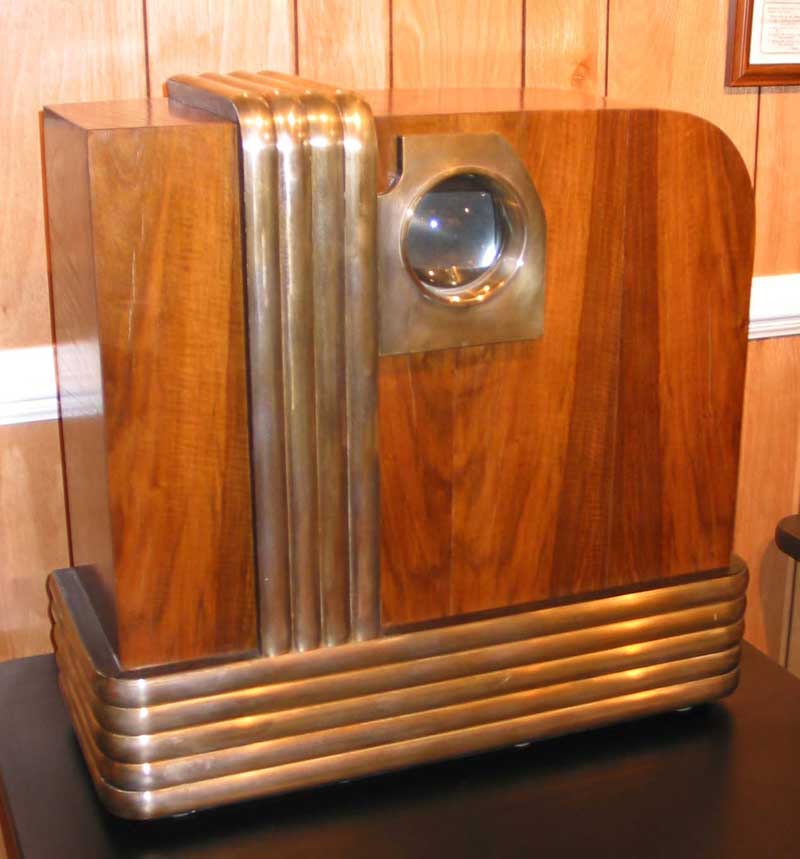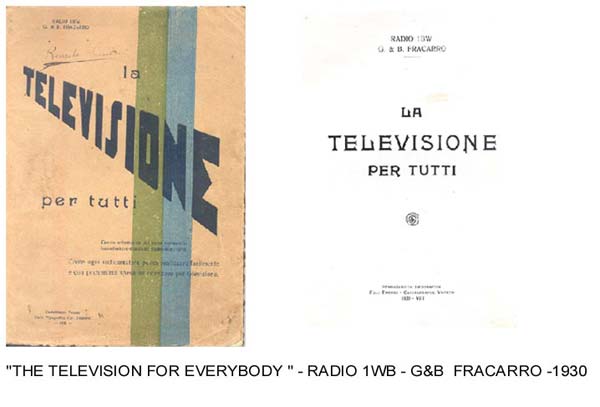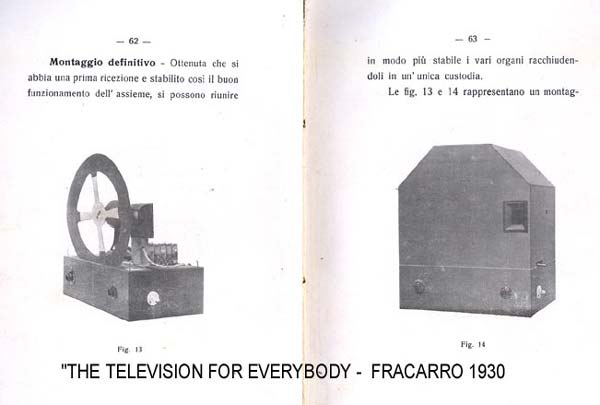Mechanical Television
Fracarro 30 Line
http://www.earlytelevision.org/fracarro_30_line.html

(click on picture for high resolution image)
This set was made in Italy between 1929 and 1932. It is for the 30
line horizontal scanning standard used by Germany at the time. The condition of the set (it was supposedly
found at a flea market in Italy) has made many collectors who have
seen pictures question whether it might be an elaborate fake.

At the top the neon tube is mounted horizontally (because the aspect
ratio is 4:3). On the shelf, from left to right, are the motor speed
control, the motor and disk, and the syncronizing asembly, with
connecting terminal strips in front of them. At the botom is a switch
(probably not original) and a slide resistor for coarse motor speed.
The scanning disk is aluminum, with steel bolts and nuts attached.
Synchronization is accomplished by these bolts and nuts passing
through electromagnets (left side) on either side of the disk. This
is similar to the method used by the Baird Televisor, which has a
"phonic wheel" on the motor shaft with a set of teeth for
each line which passes next to a pair of electromagnets.
The German standard was 4:3 aspect ratio, the same as the present
U.S. system. Baird used a 3:7 ratio for his 30 line system, and used
vertical scanning.
We have completed authenticating it. All of the experts we have talked to agree that it was made in
the 1930s.

This is a closeup of the synchronizing assembly. The disk is visible
on the right side, with one of the steel buttons.

These are the labels next to the input connectors


PDF document of the complete booklet
Fraccaro made this less elaborate receiver in 1930. It uses 30 line
vertical scanning.
We have learned some more about the history of the Fracarro company.
The following is from the Fracarro Radioindustrie website:
Giovanni and Bruno Fraccaro are the founders of Gruppo Fracarro's
parent company. When boys, they shared their passion for radio
frequency and used to build interphone and radio devices; they were
able to receive television signals from London and Berlin and were
among the first to build Nipkow disks, forerunners of modern televisions.
When in 1933 they decided to turn their passion into business, a
slip of the pen made their name become "Fracarro", with one
"c" and a double "r", while in their last name it
is the other way round.
The 40's and the 50's: lamps and later television!
Immediately after the war Fracarro enters into the industrial
phase with the mass production of ballasts for fluorescent lamps -
soon becoming the national leader in this field.
During the 50's, with the coming of television, Fracarro conquers
Italy and many other countries all over the world with its VHF aerials.
The 60's and 70's: The Lady of aerials. This is the name Fracarro
wins in the 60's and the 70's, reaching in Italy an 80% market share
in the television reception systems industry. The 80's: satellite and
security. In 1979, Fracarro becomes a joint-stock company and Umberto
Fraccaro Genovese, the founders' nephew, becomes Managing Director.
Two years later, the company enters into the satellite reception
industry and inaugurates the new research and development laboratory.
In 1984, thanks to its knowledge of technique and market, Fracarro
decides to diversify its activities. The Security Division starts up,
and a few years later is enriched by the acquisition of Sylco,
producer of optical and acoustic signalling devices
|
|

Bruno Fracarro
|

Giovanni Fracarro
|
We hope to get more information about the history of this company.
There is one discrepancy in this account. The book we have, titled La
Televisione Per Tutti was published in 1930, and is from the G
& B Fracarro Co. Note tbat the spelling of Fracarro is the
"new" one, indicating that the company was formed in 1930
or earlier, not 1933.
It seems likely that the elaborate design of the cabinet was part of
the Fracarro's attempt to market their television products.
The following came from Gino Brizioli:
I have seen the Fracarro tv disk receiver in your site, I
don't know if this equipment is original or not, but I have seen
that the front shows a lictorial emblem, the symbol of the Italian
fascist era. This symbol was used in the architecture of the
1930's and in some radio receivers (for example in Radiobalilla and
Radiorurale).
|
| 
